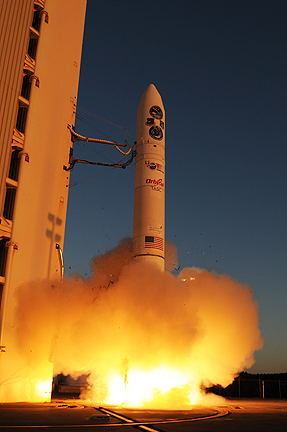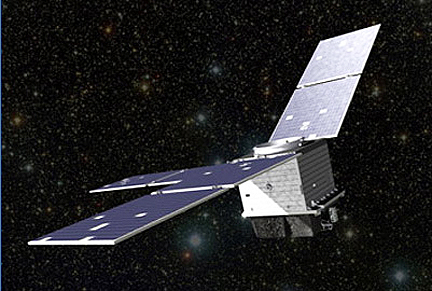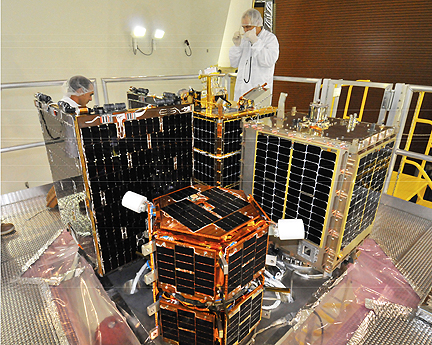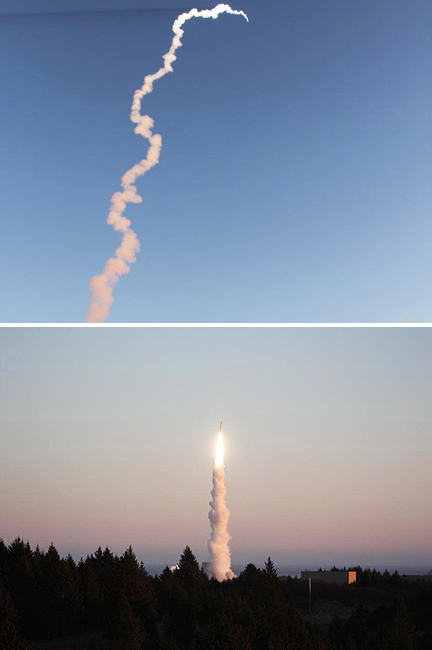Air Force Space Command, SMC, NASA... Minotaur Successfully Moves Two Crucial Products Skywards (Launch)
[SatNews] STP-S26
 STP-S26 launch, photo courtesy USAF
STP-S26 launch, photo courtesy USAF
The launch occurred from
Kodiak Launch Complex, Kodiak, AK at 4:25 p.m. AST on Friday. The satellites began deploying 17 minutes after launch vehicle ignition and concluded with the separation of two ballasts in a second orbit, one hour and 33 minutes from lift-off. This marks a great achievement by the DoD STP as its most complex mission in over 20 years. The STP-S26 mission carried a record-setting 16 experiments to space, significantly advancing our nation’s space science and technologies.
“STP-S26’s successful launch marks an important milestone with the space community,” said Col.
Carol Welsch, Director of the
DoD Space Test Program. “Researchers across the DoD, NASA, and academia will use our results to improve our nation’s space capabilities and better understand the space environment.”
 STPSat-2, artistic rendition courtesy of Ball Aerospace
STPSat-2, artistic rendition courtesy of Ball Aerospace
“Today’s successful launch and spacecraft deployment was the result of a joint collaboration among 20 mission partners and would not have been possible without the dedication of this diverse team” said Col.
Michael Moran, Space Development and Test Director and the Mission Director for STP-S26. A few of the mission partners include
Orbital Sciences Corporation,
Alaska Aerospace Corporation,
Ball Aerospace and Technologies Corporation, the
Aerospace Corporation,
TASC Inc., and many others. “My thanks to our government and industry team who together delivered on mission success.
Tomorrow’s warriors will look back to this day and thank you for the science and technology you put on orbit” said Col.
Moran.
STP-S26’s primary payload on this mission is
STPSat-2, which has now started receiving its initial on-orbit signals. “This is an exciting time for all of us here at the Space Test Program,” said Col.
Welsch. “With our mission partner on STPSat-2, Ball Aerospace and Technologies Corporation, we have reached a huge milestone in creating STP’s Standard Interface Vehicle. SIV will enable the Air Force to meet its need for affordable and rapid access to low earth orbit into the next decade."
FASTSAT
NASA's Fast, Affordable, Science and Technology Satellite, or FASTSAT, launched at 7:25 p.m. CST Friday aboard a Minotaur IV rocket from Kodiak Launch Complex on Kodiak Island, Alaska. FASTSAT is a unique platform that can carry multiple small payloads to low-Earth orbit creating opportunities for researchers to conduct low-cost scientific and technology research on an autonomous satellite in space.
 Four satellites sit atop the Minotaur IV launch vehicle that will launch them to space Nov. 19 on the Space Test Program S26 mission. (Lou Hernandez/Air Force Space & Missile Systems Center)
Four satellites sit atop the Minotaur IV launch vehicle that will launch them to space Nov. 19 on the Space Test Program S26 mission. (Lou Hernandez/Air Force Space & Missile Systems Center) separated from the Minotaur IV rocket approximately 22 minutes after launch, entering low-Earth orbit 406 miles above Earth and immediately began powering up the spacecraft. NASA ground stations are tracking the spacecraft and the spacecraft has been activated. The small satellite command center located at the
Huntsville Operations and Science Control Center at
NASA's
Marshall Space Flight Center in Huntsville, Ala., is continuing commissioning operations of the satellite. For the first 11 days after launch, the spacecraft and six onboard atmospheric and technology demonstration experiments will go through an on-orbit commissioning phase. Once commissioning is complete, the next 180 days will be focused on science operations. A checkout and performance analysis of each science instrument will be performed and then, one by one, each experiment will turn on to perform its science objectives.
 FASTSAT launches from Kodiak, Alaska. (Credit: Steven Young/Spaceflight Now)
FASTSAT launches from Kodiak, Alaska. (Credit: Steven Young/Spaceflight Now)
After the science phase is complete, additional characterization of the spacecraft will be performed to test additional flight objectives. These operations will be performed in parallel to test the overall abilities of the spacecraft. This will occur for approximately 100 days. After completion of this phase of the mission, the command will be sent to shut down the spacecraft, which will go into a decommissioning phase. The microsatellite FASTSAT, weighing just under 400 pounds, will serve as a scientific laboratory containing all the resources needed to carry out scientific and technology research operations for the mission time period. FASTSAT was developed with a simplicity in the design of the spacecraft subsystems that provide power management, onboard storage of experiments data, control of experiments, communications with ground stations, propellantless mechanisms for attitude control and a GPS system for navigation.
FASTSAT launched on the
STP-S26 mission — a joint activity between NASA and the U.S.
Department of Defense Space Test Program. The satellite was designed, developed and tested at the Marshall Center in partnership with the
Von Braun Center for Science & Innovation and Dynetics Inc. of Huntsville. Dynetics provided key engineering, manufacturing and ground operations support for the new microsatellite. Thirteen Huntsville-area firms, as well as the
University of Alabama in Huntsville, also were part of the project team.
Topical Tags :
Regional Tags :





